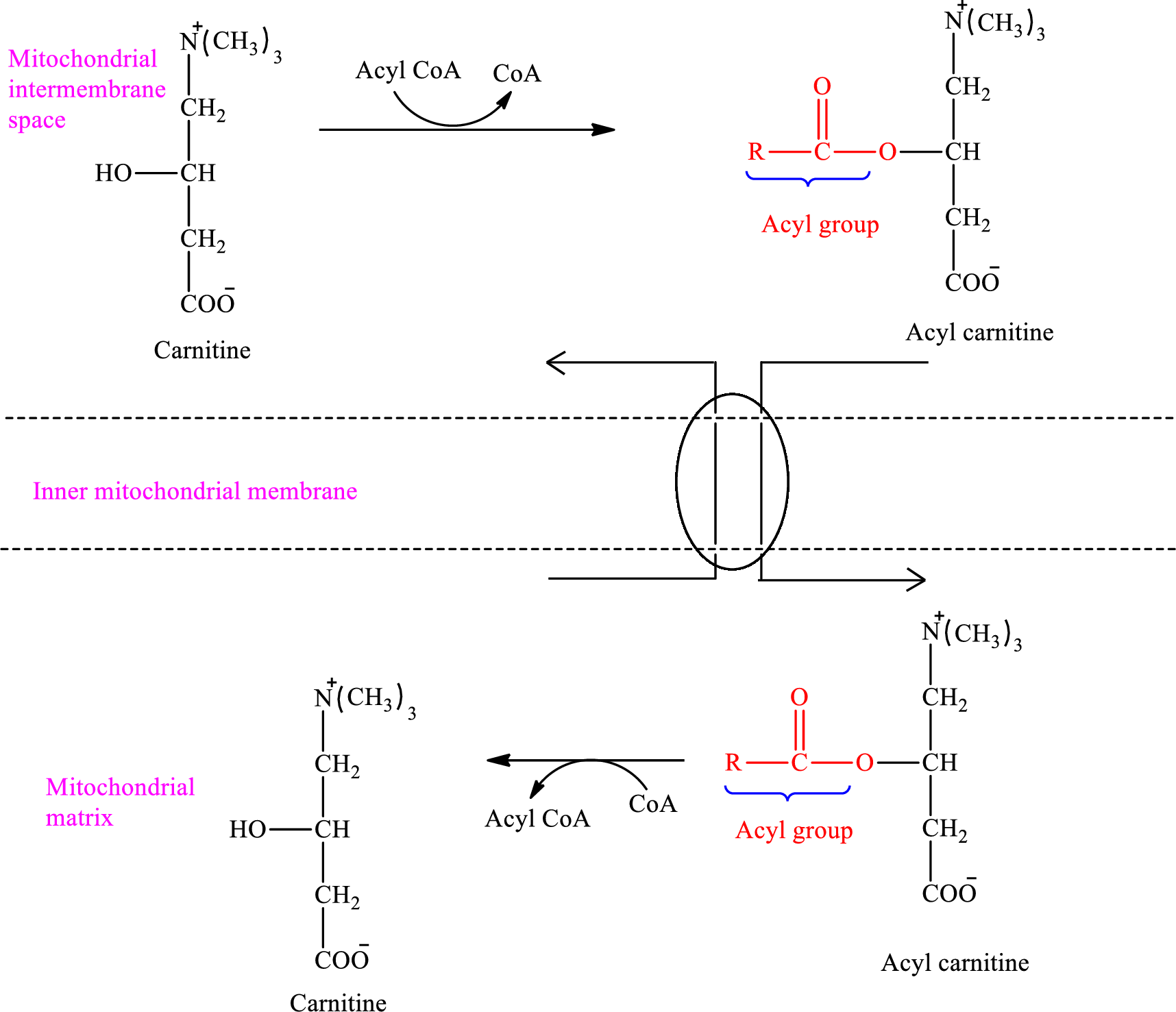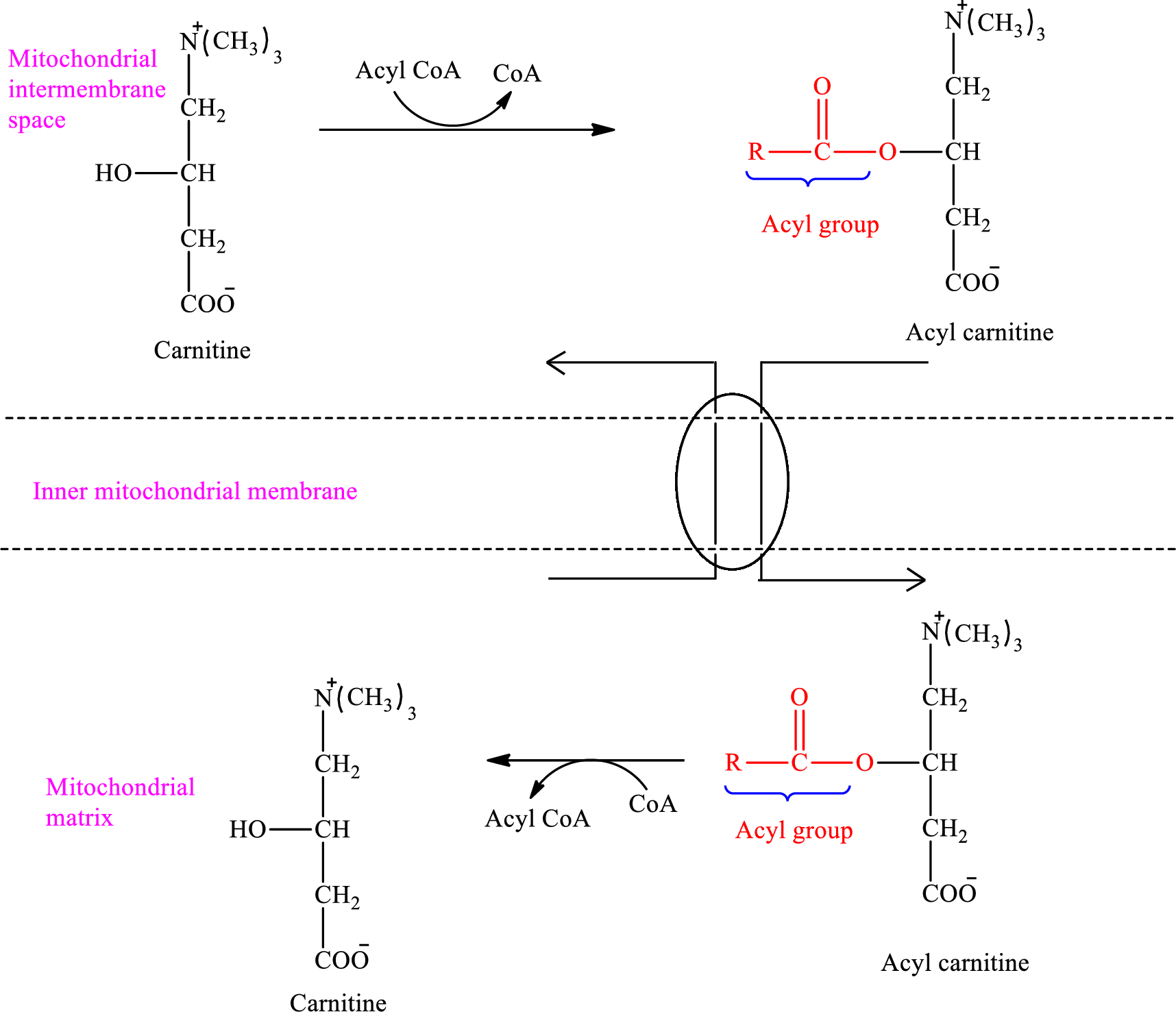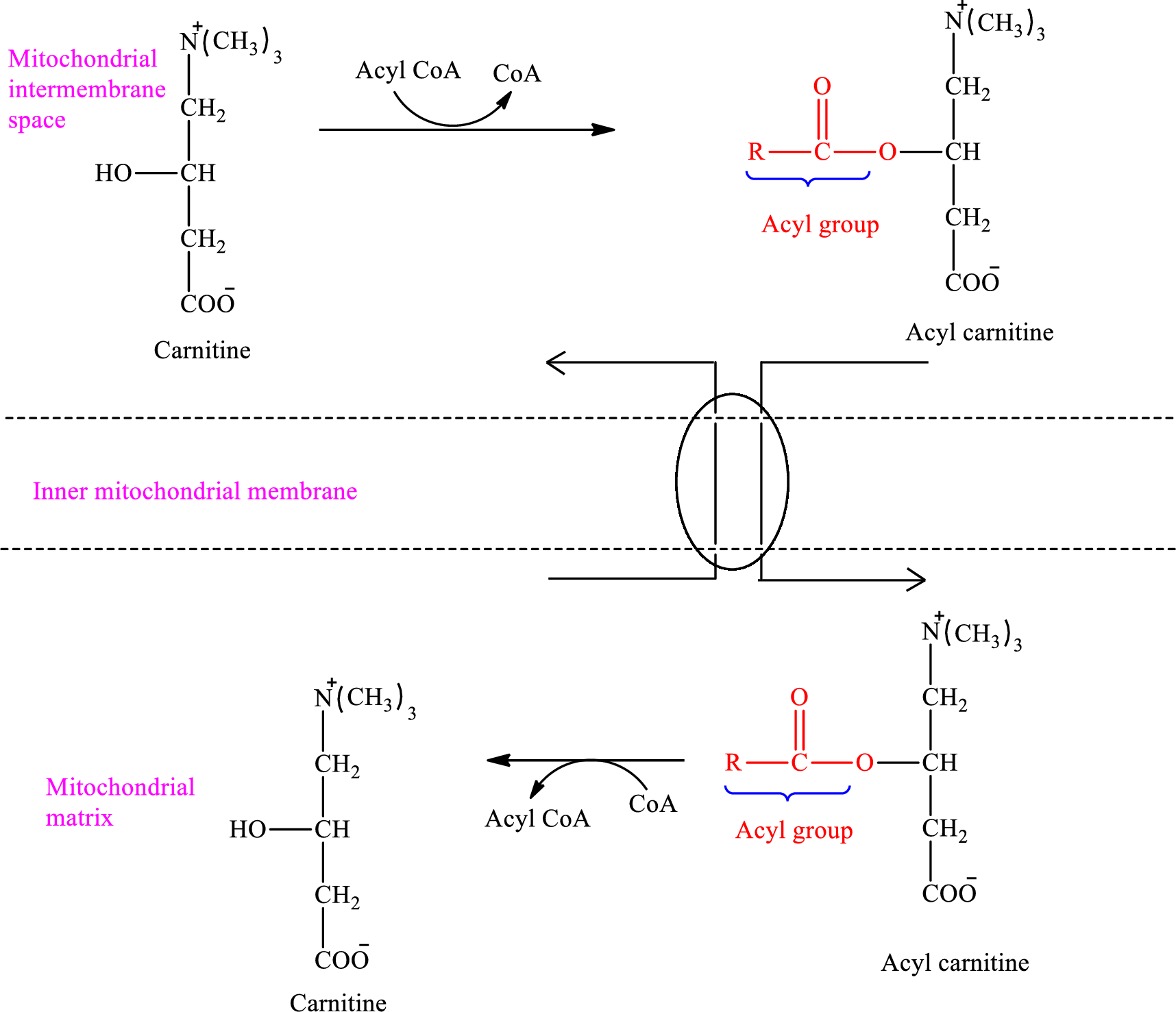
Concept explainers
(a)
Interpretation:
Whether “
Concept Introduction:
The fatty acids are broken down to provide energy. The breakdown of fatty acids is a three parts process. In the first part, the fatty acid is activated. In the second part, the transportation of fatty acid into the mitochondrial matrix is facilitated by a shuttle mechanism. In the third part, the fatty acid is readily oxidized, cycling through a series of four reactions.
The
The first stage of fatty acid oxidation is the activation of fatty acids in the outer mitochondrial membrane. The fatty acid is activated by
(a)
Answer to Problem 25.25EP
Explanation of Solution
The enzymes that are needed for the oxidation of fatty acid are located in the mitochondrial matrix. Acyl CoA cannot pass through the inner mitochondrial membrane to the mitochondrial matrix because it is too large. A shuttle mechanism that involves the molecule carnitine effects the entry of Acyl CoA into the mitochondrial matrix.
An overview of the transportation of Acyl CoA in the carnitine shuttle system associated with the

Therefore, Acyl CoA is encountered as a reactant in the intermembrane space.
(b)
Interpretation:
Whether “carnitine enters the inner mitochondrial membrane” in the mitochondrial matrix or in the mitochondrial intermembrane space in the carnitine shuttle system associated with the
Concept Introduction:
The fatty acids are broken down to provide energy. The breakdown of fatty acids is a three parts process. In the first part, the fatty acid is activated. In the second part, the transportation of fatty acid into the mitochondrial matrix is facilitated by a shuttle mechanism. In the third part, the fatty acid is readily oxidized, cycling through a series of four reactions.
The
The first stage of fatty acid oxidation is the activation of fatty acids in the outer mitochondrial membrane. The fatty acid is activated by
(b)
Answer to Problem 25.25EP
Carnitine enters the inner mitochondrial membrane in the mitochondrial matrix.
Explanation of Solution
The enzymes that are needed for the oxidation of fatty acid are located in the mitochondrial matrix.
An overview of the transportation of

Carnitine molecule shuttles the activated fatty acid molecules across the inner mitochondrial membrane. Therefore, carnitine enters the inner mitochondrial membrane in the mitochondrial matrix.
(c)
Interpretation:
Whether “carnitine is converted to acyl carnitine” in the mitochondrial matrix or in the mitochondrial intermembrane space in the carnitine shuttle system associated with the
Concept Introduction:
The fatty acids are broken down to provide energy. The breakdown of fatty acids is a three parts process. In the first part, the fatty acid is activated. In the second part, the transportation of fatty acid into the mitochondrial matrix is facilitated by a shuttle mechanism. In the third part, the fatty acid is readily oxidized, cycling through a series of four reactions.
The
The first stage of fatty acid oxidation is the activation of fatty acids in the outer mitochondrial membrane. The fatty acid is activated by
The enzymes that are needed for the oxidation of fatty acid are located in the mitochondrial matrix.
(c)
Answer to Problem 25.25EP
Carnitine is converted to acyl carnitine in the mitochondrial intermembrane space.
Explanation of Solution
Acyl group present in
An overview of the transportation of

Therefore, carnitine is converted to acyl carnitine in the mitochondrial intermembrane space.
(d)
Interpretation:
Whether “free
Concept Introduction:
The fatty acids are broken down to provide energy. The breakdown of fatty acids is a three parts process. In the first part, the fatty acid is activated. In the second part, the transportation of fatty acid into the mitochondrial matrix is facilitated by a shuttle mechanism. In the third part, the fatty acid is readily oxidized, cycling through a series of four reactions.
The
The first stage of fatty acid oxidation is the activation of fatty acids in the outer mitochondrial membrane. The fatty acid is activated by
The enzymes that are needed for the oxidation of fatty acid are located in the mitochondrial matrix.
(d)
Answer to Problem 25.25EP
Free
Explanation of Solution
Acyl group present in
An overview of the transportation of

Therefore, free
Want to see more full solutions like this?
Chapter 25 Solutions
General, Organic, and Biological Chemistry
- Which of the following statements are TRUE?Multiple answers are accepted for this question a .Two molecules of CO2 are produced each time a molecule of Acetyl-CoA is oxidized. b. During the first turn of the TCA Cycle the carbon atoms of Acetyl-CoA become CO2. c. The number of molecules of ATP that can be produced in the Citric Acid Cycle by substrate level phosphorylation of ADP from two molecules of Acetyl-CoA is 30. d. Fumarate contains a trans double bond. The cis isomer of Fumarate is Maleate which cannot serve as carbon source for a cell. e. Lack of O2 would decrease the rate of the Citric Acid Cycle in red blood cells. f. If a potent inhibitor of Succinyl-CoA Synthetaseis is applied to liver cells both energy production and synthesis of carbohydrate would be affected. g. The overall chemical changes that occur during one complete turn of the Citric Acid Cycle is the complete oxidation of one molecule of Acetyl-CoA plus the production of two molecules of CO2 plus the…arrow_forwardAn essential characteristic of the malate-aspartate electron shuttle is that? A. it is a NADH/aspartate antiport located in the inner mitochondrial membrane B. it involves a malate dehydrogenase embedded in the mitochondrial inner membrane C. it shuttles the electrons from NADH across the mitochondrial membrane to allow NADH formation inside the mitochondrial matrix D. glycerol-3-phosphate is a key component of this shuttle processarrow_forwardWhich of the following is incorrect about the fifth step (conversion of succinyl-CoA, GDP, and Pi to succinate and GTP) of the citric acid cycle? a. GTP is made because succinyl-CoA is a thioester b. It is not regulated c. It involves a "substrate level" phosphorylation of GDP d. It is irreversiblearrow_forward
- The mitochondrial membrane potential is an indicator of cell viability. Think about mitochondrial function and decide which of these statements best describes the mitochondrial membrane potential. a.) A voltage that reflects the movement of ATP across the outer mitochondrial membrane b.) A voltage that reflects the movement of protons across the outer mitochondrial membrane c.) A voltage that reflects the movement of protons across the inner mitochondrial membrane d.) A voltage that reflects the movement of ATP across the inner mitochondrial membranearrow_forwarda) Make a theoretical calculation of how many ATP molecules can be formed from the breakdown of a molecule of Acetyl- CoA into carbon dioxide and water. The prerequisite is that the entire proton gradient across the mitochondrial inner membrane can be used for ATP production and that the ATP synthase has 6 c-subunits.arrow_forwardWhich of the following statements is true about the citric acid cycle a. The Citric Acid Cycle is an 8-step cycle that produces the most electron carrier molecules throughout the process of cellular respiration. b. In Citric Acid Cycle, both the acetyl group and coenzyme A of Acetyl CoA are combined to oxaloacetate. c. In Citric Acid Cycle, glucose is only partially broken down and there are still remnants of glucose after this process. d. The ATP produced during this process is via oxidative phosphorylationarrow_forward
- Concerning the citric acid cycle (TCA cycle), which of the following statements is false? a. Substrate level phosphorylation in the TCA cycle produces 2 GTP per the oxidation of a single glucose molecule b. The TCA cycle generates electron carriers c. Oxidation of pyruvate in the matrix of the mitochondria produces sixteen total electrons d. The fate of the carbonyl carbon of acetyl CoAin the TCA cycle is to be lost as CO2 in the second turn e. Radiolabeling of the methyl carbon of pyruvate in the TCA cycle shows the carbon signal to split through successive turnsarrow_forwardsuccinyl-COA synthetase will do which of the following: Select one: a. Fumarate is combined with water to become Malate b. alpha-ketoglutarate is oxidized and decarboxylated to produce Succinyl-CoA, Carbon dioxide and NADH c. Succinate is oxidized to become fumarate forming FADH2 d. Citrate is rearranged to become Isocitrate e. Malate is oxidized to become oxaloacetate forming NADH f. Pyruvate is decarboxylated to become acetyl-CoA producing NADH and Carbon dioxide g. Succinyl-CoA becomes Succinate and forms one ATP molecule and Coenzyme A-SH h. Oxaloacetate combines with the acetyl from acetyl-CoA to produce Citric acid(citrate) i. Isocitrate and then decarboxylated and oxidized to produce alpha-ketoglutarate, Carbon dioxide and NADHarrow_forwardidentify the reactions of the citric acid cycle that provide reducing power for the electron-transport chain a. conversion of succinyl-CoA to succinate b. conversion of fumarate to malate c. conversion of succinate to fumarate d. conversion of malate to oxaloacetatearrow_forward
- The formation of acetyl CoA... A) occurs in the mitochondrial matrix, after moving across the outer and inner mitochondrial membrane. B) occurs in the cytoplasm prior to transport into the mitochondrial matrix. C) involves activation of acyl groups derived from pyruvate. D) A and C E) B and Carrow_forwardFive coenzymes are required by a-ketoglutarate dehydrogenase, the enzyme in the citric acid cycle that converts a-ketoglutarate to succinyl-CoA.a. Identify the coenzymes.b. Propose a mechanism for the reaction.arrow_forwardOutline the role of carnitine in the transport of acyl-CoA molecules into the mitochondrion. How many enzymes are involved? What are they called?arrow_forward
 Human Anatomy & Physiology (11th Edition)BiologyISBN:9780134580999Author:Elaine N. Marieb, Katja N. HoehnPublisher:PEARSON
Human Anatomy & Physiology (11th Edition)BiologyISBN:9780134580999Author:Elaine N. Marieb, Katja N. HoehnPublisher:PEARSON Biology 2eBiologyISBN:9781947172517Author:Matthew Douglas, Jung Choi, Mary Ann ClarkPublisher:OpenStax
Biology 2eBiologyISBN:9781947172517Author:Matthew Douglas, Jung Choi, Mary Ann ClarkPublisher:OpenStax Anatomy & PhysiologyBiologyISBN:9781259398629Author:McKinley, Michael P., O'loughlin, Valerie Dean, Bidle, Theresa StouterPublisher:Mcgraw Hill Education,
Anatomy & PhysiologyBiologyISBN:9781259398629Author:McKinley, Michael P., O'loughlin, Valerie Dean, Bidle, Theresa StouterPublisher:Mcgraw Hill Education, Molecular Biology of the Cell (Sixth Edition)BiologyISBN:9780815344322Author:Bruce Alberts, Alexander D. Johnson, Julian Lewis, David Morgan, Martin Raff, Keith Roberts, Peter WalterPublisher:W. W. Norton & Company
Molecular Biology of the Cell (Sixth Edition)BiologyISBN:9780815344322Author:Bruce Alberts, Alexander D. Johnson, Julian Lewis, David Morgan, Martin Raff, Keith Roberts, Peter WalterPublisher:W. W. Norton & Company Laboratory Manual For Human Anatomy & PhysiologyBiologyISBN:9781260159363Author:Martin, Terry R., Prentice-craver, CynthiaPublisher:McGraw-Hill Publishing Co.
Laboratory Manual For Human Anatomy & PhysiologyBiologyISBN:9781260159363Author:Martin, Terry R., Prentice-craver, CynthiaPublisher:McGraw-Hill Publishing Co. Inquiry Into Life (16th Edition)BiologyISBN:9781260231700Author:Sylvia S. Mader, Michael WindelspechtPublisher:McGraw Hill Education
Inquiry Into Life (16th Edition)BiologyISBN:9781260231700Author:Sylvia S. Mader, Michael WindelspechtPublisher:McGraw Hill Education





